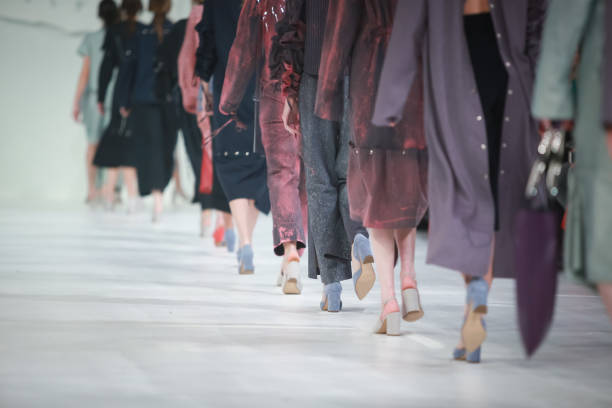How Fashion Will Change In Future
Fashion is an ever-evolving industry influenced by a variety of factors such as technology, sustainability concerns, cultural shifts, and consumer demands. While it's hard to predict the future with complete accuracy, we can make educated guesses about how fashion might change based on current trends and emerging technologies. Here are some possible directions fashion could take in the future:

Sustainability
and Ethical Manufacturing
- Eco-Friendly
Materials: There will likely be a surge in the use of sustainable,
recycled, and lab-grown materials, replacing traditional cotton, leather,
and synthetics.
- Local
Production: With increased awareness of the carbon footprint
associated with shipping, we may see a move towards local sourcing and
manufacturing.
- Circular
Fashion: Concepts like rent, repair, and recycle will gain importance.
Brands might offer services to repair or recycle garments, encouraging a
circular fashion economy.
- Transparency:
Brands will be under increasing pressure to disclose their manufacturing
practices, promoting ethical labor conditions.
Technology-Driven
Changes
- Smart
Fabrics: Textiles could be integrated with smart technology to provide
additional functionalities like temperature regulation, health monitoring,
or even mood alteration.
- Virtual
Reality and Augmented Reality: These technologies could redefine how
we shop for clothes, allowing people to try on outfits in virtual fitting
rooms or see how a piece of clothing will look on them through augmented
reality apps.
- 3D
Printing: Customization will be easier and more accessible through 3D
printing of clothes.
- Blockchain:
Technology like blockchain could offer secure and transparent methods of
tracking the lifecycle of products, from raw material to retail.
- AI
and Data Analytics: Brands will use data analytics for better
inventory management and AI for personalized customer experiences.
Cultural
and Social Influences

- Inclusivity:
The fashion industry will likely become more inclusive, catering to a
wider range of sizes, genders, and cultural backgrounds.
- Cultural
Fusion: As the world becomes more interconnected, we'll likely see an
amalgamation of different styles and cultural garments in mainstream
fashion.
- Activism:
Fashion will increasingly become a platform for social and political
statements.
- Work
Attire: With the increase in remote working, casual and comfortable
clothing may become more standard, even in professional settings.
Fast
Fashion vs Slow Fashion
Fast Fashion
Characteristics:
- High Turnover: Fast fashion brands often
produce new collections on a weekly basis to keep consumers engaged.
- Low Cost: The clothes are usually
inexpensive, allowing people to constantly update their wardrobe.
- Mass Production: To meet consumer demand
and keep costs low, these brands often mass-produce their items.
- Trend-Driven: Fast fashion caters to the
latest trends, replicating designs seen on high-end fashion runways and in
celebrity culture.
Advantages:
- Accessibility: Fast fashion is
financially accessible for a broad demographic, allowing more people to
participate in current fashion trends.
- Variety: With new collections introduced
frequently, consumers have a wide variety of choices.
- Economic Benefits: Fast fashion employs
a large number of people and contributes significantly to the retail
economy.
Disadvantages:
- Environmental Impact: Fast fashion is a
major contributor to pollution, waste, and overuse of resources.
- Poor Labor Conditions: To keep
production costs low, many fast fashion brands exploit workers in
developing countries.
- Quality: The emphasis on speed and cost
often leads to compromised quality.
- Short Lifecycle: Fast fashion items are
often disposed of quickly, contributing to enormous textile waste.
Slow Fashion

Characteristics:
- Quality Over Quantity: Slow fashion
emphasizes well-crafted, durable goods.
- Sustainability: Eco-friendly materials
and ethical manufacturing processes are often a priority.
- Timeless Design: Unlike the trend-driven
nature of fast fashion, slow fashion often focuses on timeless pieces that
won't go out of style quickly.
- Local Production: Slow fashion brands
often prioritize local manufacturing and sourcing.
Advantages:
- Environmental Responsibility: Slow
fashion generally has a much lower carbon footprint compared to fast
fashion.
- Ethical Practices: Fair labor conditions
and wages are a cornerstone of the slow fashion movement.
- Longevity: High-quality materials and
craftsmanship mean that slow fashion items usually last longer, making
them more cost-effective in the long run.
- Personal Connection: With an emphasis on
craftsmanship, consumers often feel a stronger connection to slow fashion
items.
Disadvantages:
- High Costs: The ethical and quality
considerations often result in higher retail prices, making these items
less accessible to some consumers.
- Limited Choices: The focus on quality
and sustainability often means less variety and fewer collections per
year.
- Inconvenience: Sourcing and purchasing
slow fashion can be more time-consuming than walking into a fast fashion
outlet.
- With growing awareness of environmental
sustainability and ethical practices, the slow fashion movement is gaining
momentum. However, fast fashion's affordability and accessibility continue
to make it a dominant force in the market. Some brands are attempting a
hybrid approach, incorporating sustainable practices while maintaining
some elements of the fast fashion model, such as a quicker turnover of
styles.
- Ultimately, the tension between fast and
slow fashion represents broader societal debates about sustainability,
consumerism, and ethics. Advances in technology, such as 3D printing and
AI, could disrupt these models further, offering new ways to achieve both
speed and sustainability.
- manner,
challenging the current fast fashion model.
Collaboration
and Community
- Designer
Collaborations: High-end brands collaborating with everyday brands
could become more common, making luxury fashion more accessible.
- Community
Driven: With social media and other platforms, users might have more
input into what brands produce, making fashion more community-oriented.
The fashion of the future will likely be a blend of these
trends, driven by consumer choices and technological advances. The only
constant will be change itself.



Comments
Post a Comment